Have you ever worn somebody else's shoes? If not, high time to do it–with customer feedback analysis, you're pretty much figuring out how it feels in your client's shoes. It is one of the most powerful things you can do to identify the right customer experience strategy, yet it's often either neglected or done superficially.
In this article, we discuss the steps involved in customer feedback analysis and some use cases. We'll also dispel some of the doubts surrounding it for those who still are hesitant.
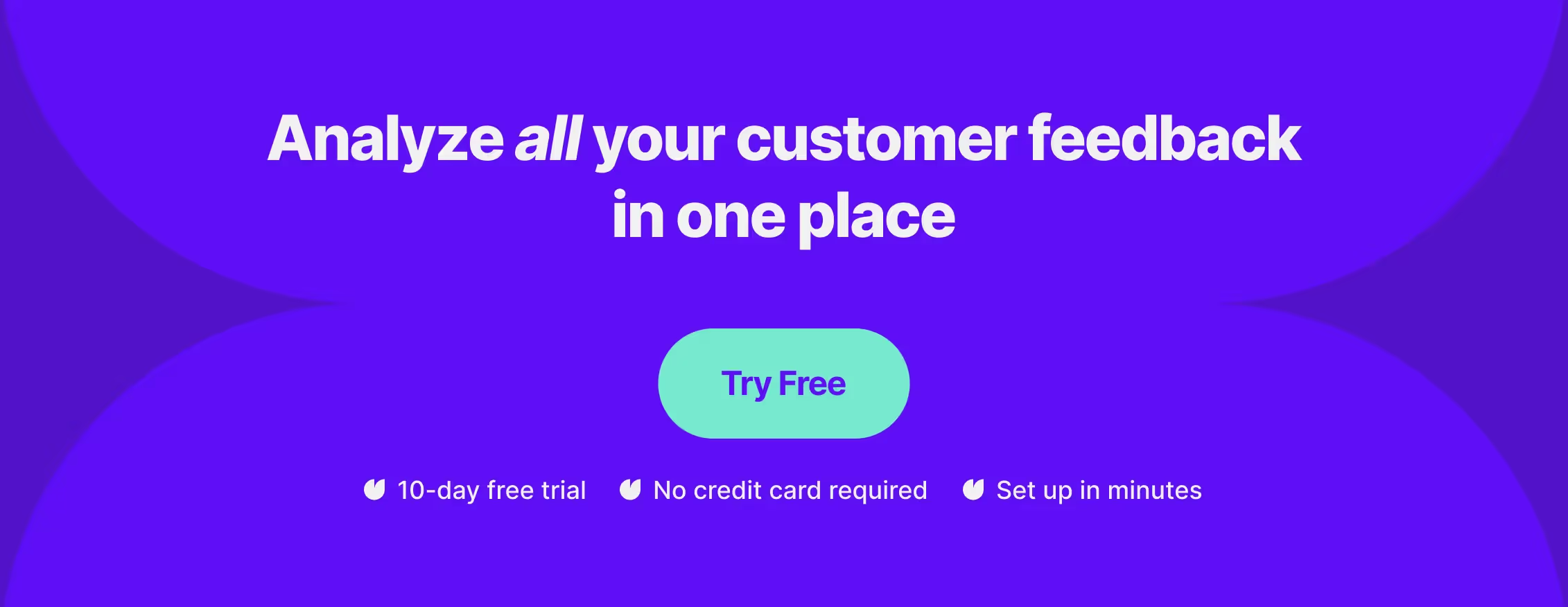
Customer feedback analysis process in 6 steps
Step 1: Collect customer feedback
You should collect customer feedback from multiple sources. Customers interact with businesses through various touchpoints—websites, mobile apps, emails, support chats, and more. A robust approach ensures that feedback is collected when and where it matters most.
Imagine a scenario where users struggle with an onboarding feature but never report it.
By implementing surveys directly within a product or website, you can capture real-time feedback before frustration leads to churn.
Similarly, sending follow-up emails after key interactions, such as purchases or support inquiries, ensures that you hear from customers when the experience is still fresh in their minds.
Mobile app users may have entirely different expectations, making in-app surveys crucial for understanding their needs.
Feedback also resides in existing conversations. Integrating survey tools with customer support platforms, CRM systems, and live chat tools lets you extract valuable insights from daily customer support interactions.
Instead of waiting for formal complaints, you can analyze organic feedback from ongoing customer communication, making it easier to spot patterns and areas for improvement.
Customer feedback surveys
Running customer feedback surveys is one of the most popular and effective ways to collect customer feedback for quite a few reasons. Not only are they easy to set up and don't require much time or effort, but they also allow you to get client feedback at scale.
With modern customer feedback analysis tools such as Survicate, you can easily send customer surveys via email, website popups, or in-app. You can also embed customer surveys on your website or blog to collect feedback from website visitors.
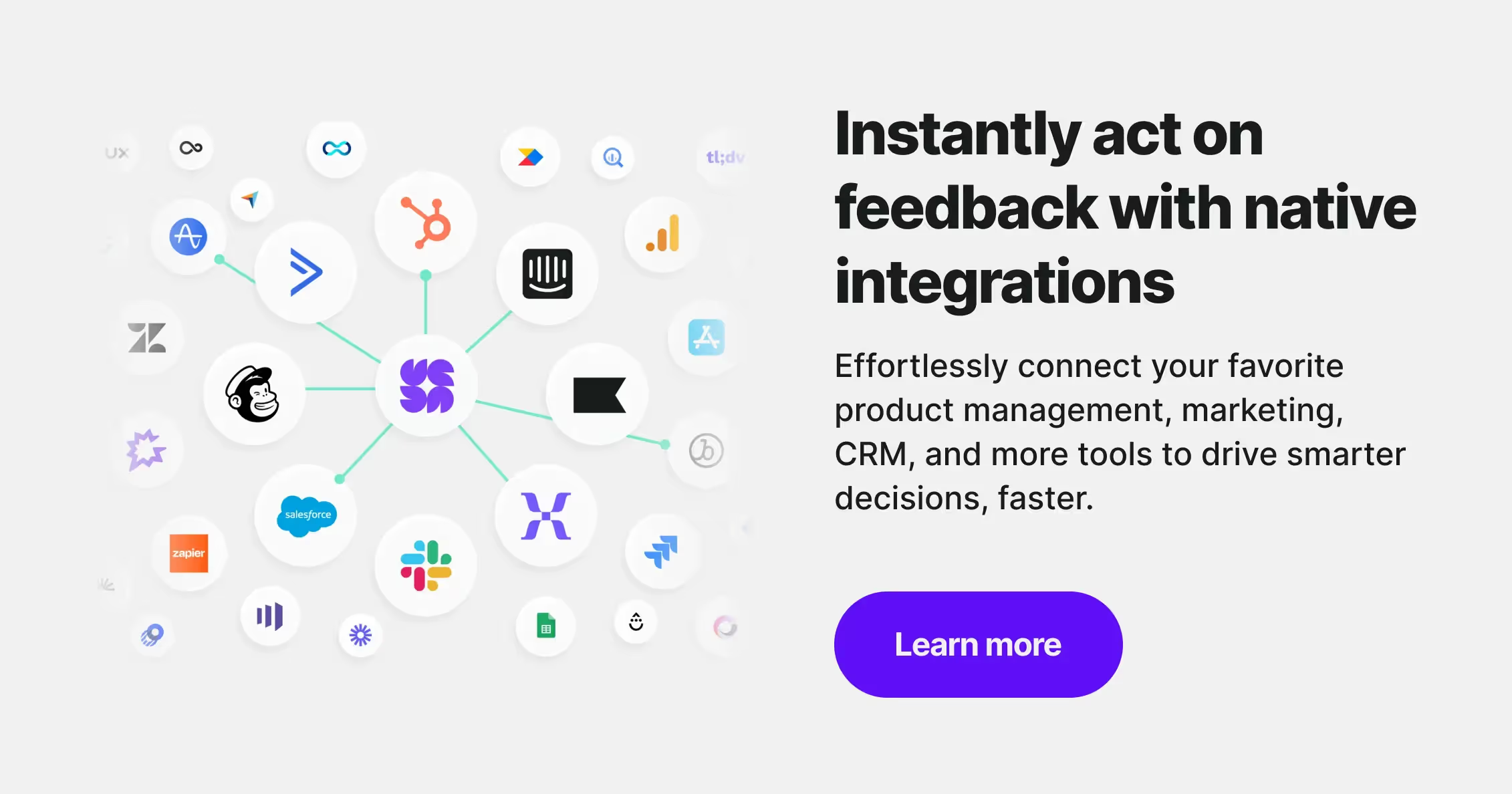
This way, you can configure and distribute:
- Customer satisfaction surveys
- NPS surveys
- CES surveys
- Any other survey you can think of
and gain insightful feedback in the blink of an eye. Surveys often play the role of customer feedback analysis tools, as they give you an overview of customer opinion on various topics in the form of customer feedback.
Customer interviews
If you want to go beyond customer feedback and get a deeper understanding of your customers' needs, wants, and pain points, customer interviews are the way to go.
Unlike customer surveys that collect feedback at scale, customer interviews are all about quality over quantity. They allow you to have a one-on-one conversation with your customer and get in-depth insights into their issues.
As great as it sounds, it's also time consuming and will require resources not only to run such an interview but also to analyze it and draw conclusions from it. However, customer interviews are definitely worth it, as they provide some of the most valuable customer feedback out there.
Customer support channels
If you're looking for customer feedback that's more on the qualitative side, you can always turn to your customer service channels such as live chat or sales calls. This type of customer feedback is usually unstructured and harder to analyze, but it can be incredibly useful nonetheless.
One way to gather customer feedback via customer support channels is by integrating and setting up triggers. For example, you can configure your customer service software to send a customer survey to customers after they close a support ticket. This allows you to get valuable insights into the quality of your customer service at the right time and in a non-intrusive way.
Don't get discouraged, though. Customer feedback gathered via customer service teams might be mostly negative or picky – after all, people usually turn to customer support when they're already unhappy with a product or service.
Online reviews
Sometimes, you need to dig a bit more – into positive reviews or negative reviews that are left without your knowledge or contacting your company.
These customer reviews can be found on popular review platforms such as Capterra, Gartner, or Trustpilot, but also on local business directories such as Google My Business or Yelp.
To get the most out of online customer reviews, you need to actively monitor and group feedback coming from these data points. This way, you can quickly spot any negative customer sentiment and address it before it's too late.
However, even if it's too late, you can still use customer reviews to gather customer feedback to perform.
Marketing channels
For social media, you can create a series of social media posts with open-ended questions to encourage people to comment and give you their feedback.
You should also keep an eye on social media comments to get insights into customer sentiment analysis and get qualitative data on how your social media performance impacts customer experience with your brand.
Email marketing can also make a valuable customer feedback platform. You can include customer feedback survey links in your newsletters or in your transactional emails.
This way, you can have quite a substantial volume of user feedback coming directly to your inbox.
You can also use customer feedback gathered via marketing channels to create targeted marketing campaigns.
For example, if you notice that many customers are unhappy with a particular product, you can target them with special discounts or coupons to win them back.
Step 2: Categorize customer feedback
In this step, you'll start categorizing customer feedback based on various factors relevant to your business. Some of them are universal like topic, sentiment, or channel the feedback piece comes from. Others may vary depending on the specificity of your niche.
For example, one of our customers, MAJORITY, segments the customers by their diaspora, or nationality backgrounds. This mobile banking app offers services to US migrants, and it is an important factor influencing user needs.
As Aura Arias, the Head of CRM at MAJORITY explains:
"As soon as we get responses, we can filter and see what the NPS is in Venezuela, Cuba, or Mexico and get a clear overview of each diaspora."
This way, if survey responses indicate that Venezuelan users are experiencing delivery issues with their cards, MAJORITY prioritizes resolving this problem for that specific group.
You should consider categorizing feedback via the following aspects:
- via sentiment analysis (positive, neutral, negative comments)
- via types of requests (bugs, features, pricing)
- via feedback channel (email, in-product, website, mobile)
- via customer journey stage (prospect, customer, churned)
Now, many of us may still remember the "joys" of manual feedback analysis. The good news is you don't have to spend hours over spreadsheets to tag and understand customer feedback.
Instead of manually sifting through responses, you can use AI-driven tools to automatically group feedback by common topics. If multiple users mention difficulties with onboarding, these comments should be flagged for immediate review. Integrations with collaboration tools like Slack or Google Sheets further help teams stay aligned and ensure that feedback flows seamlessly across teams.
The baseline you can even use ChatGPT if your company's security guidelines allow you to. Nonetheless, we'd advise a more cautious approach and employ dedicated analysis tools.
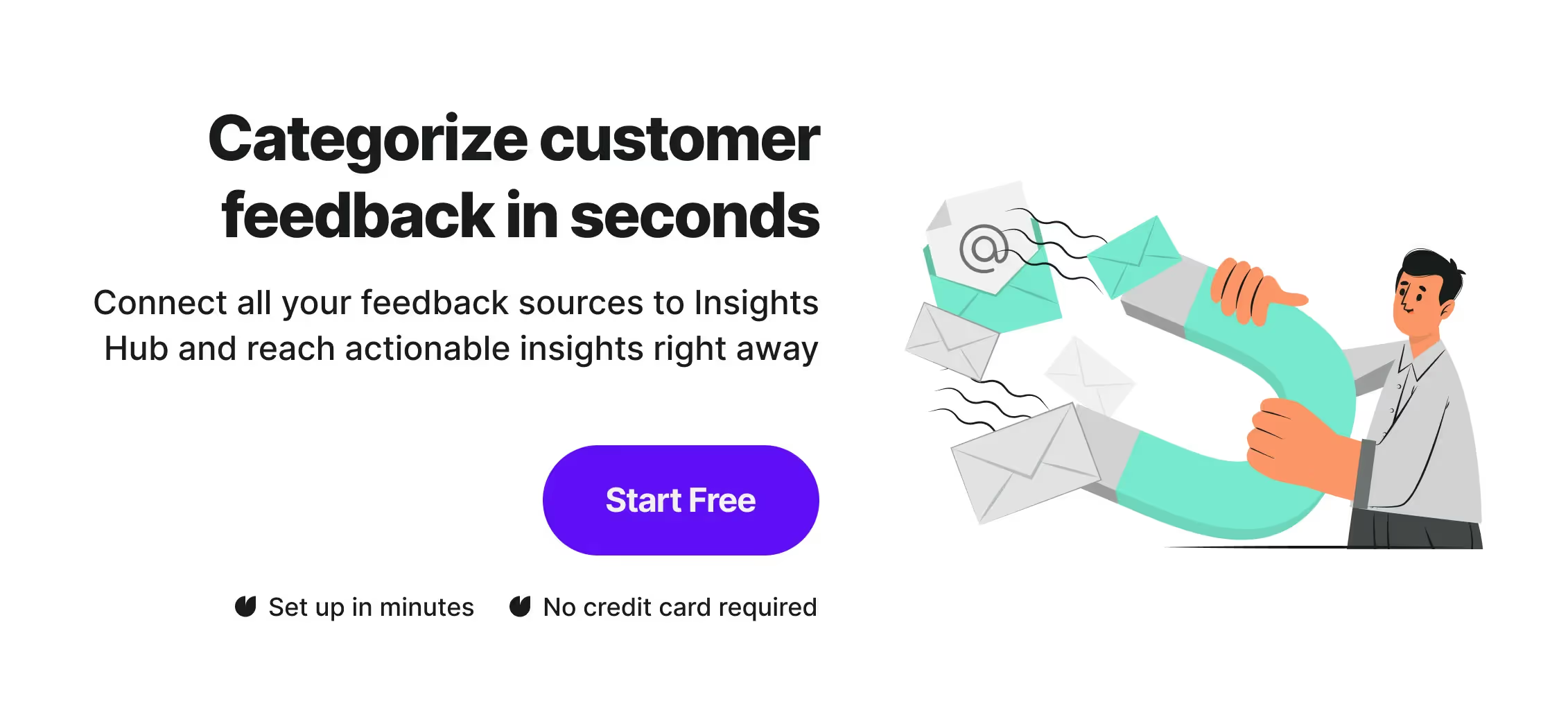
💡Tip: Survicate’s AI-driven Insights Hub automatically categorizes all incoming feedback, grouping it by sentiment, topic, or urgency. You just need to connect your sources, such as surveys, app stores, Google reviews, support channels, and emails, or upload video calls to have all your feedback sorted and in one place. This automation saves time and ensures that no critical feedback is overlooked.
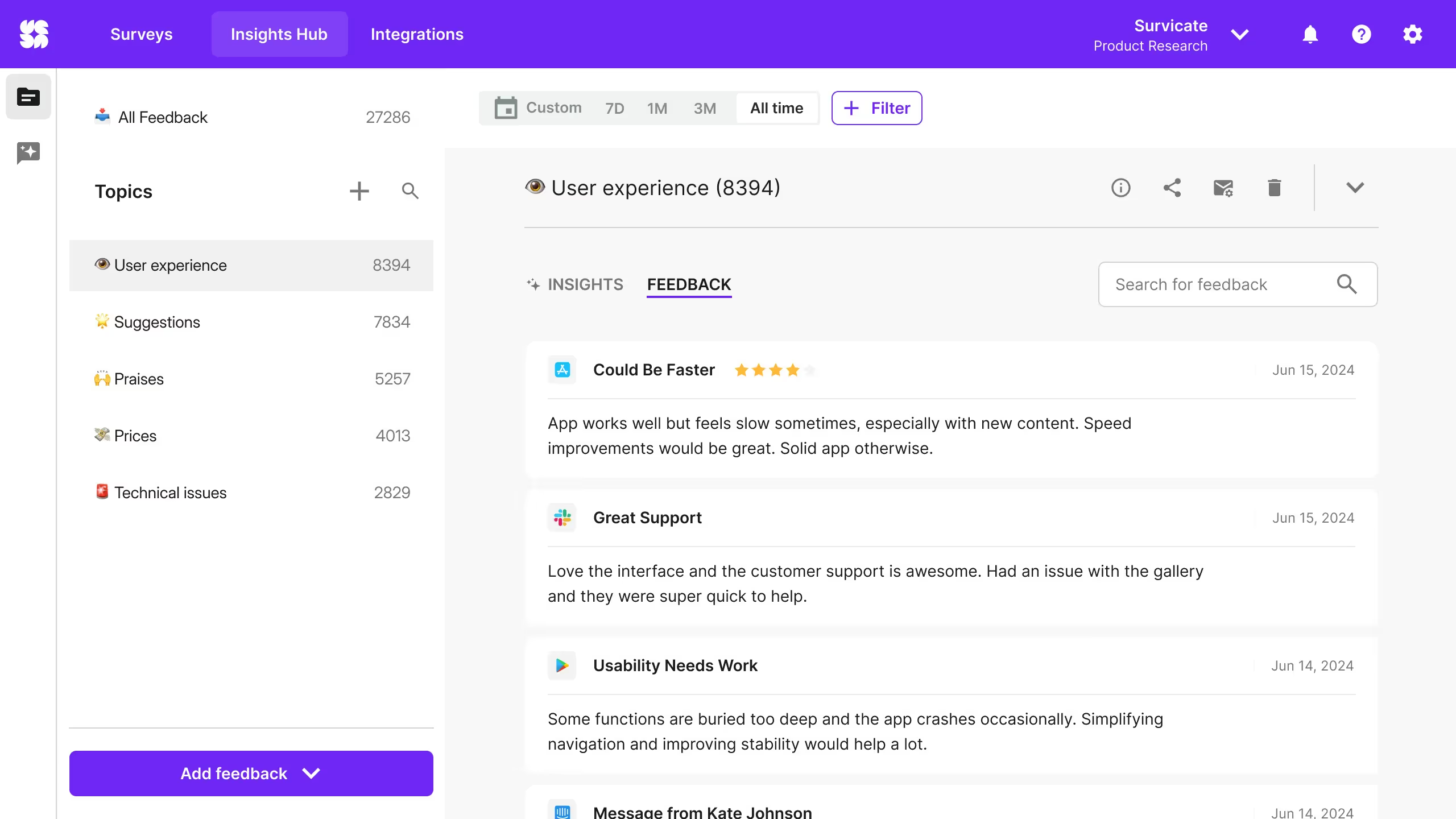
Categorizing customer feedback helps you spot any patterns and commonalities. It will also make it easier to identify areas of improvement and take action accordingly. The better you categorize all the data and provide actionable insights for implementation, the more impactful customer feedback analysis will be for your performance.
Step 3: Identify key trends and pain points
Once feedback data is structured, the next step is identifying what it reveals. Patterns in customer responses often highlight friction points in the product or service experience. You should ask:
- What are the most frequent complaints?
- Are there recurring feature requests?
- Which interactions result in positive or negative sentiment?
Analyzing feedback trends manually is tedious, especially when dealing with thousands of responses.
AI-powered assistants can help surface insights instantly. For example, a product manager investigating onboarding issues can ask, “What are the most common obstacles new users report?” and receive a breakdown of the top concerns.
Additionally, sentiment analysis process helps businesses track how customers feel over time, identifying any sudden shifts in satisfaction levels that require immediate attention.
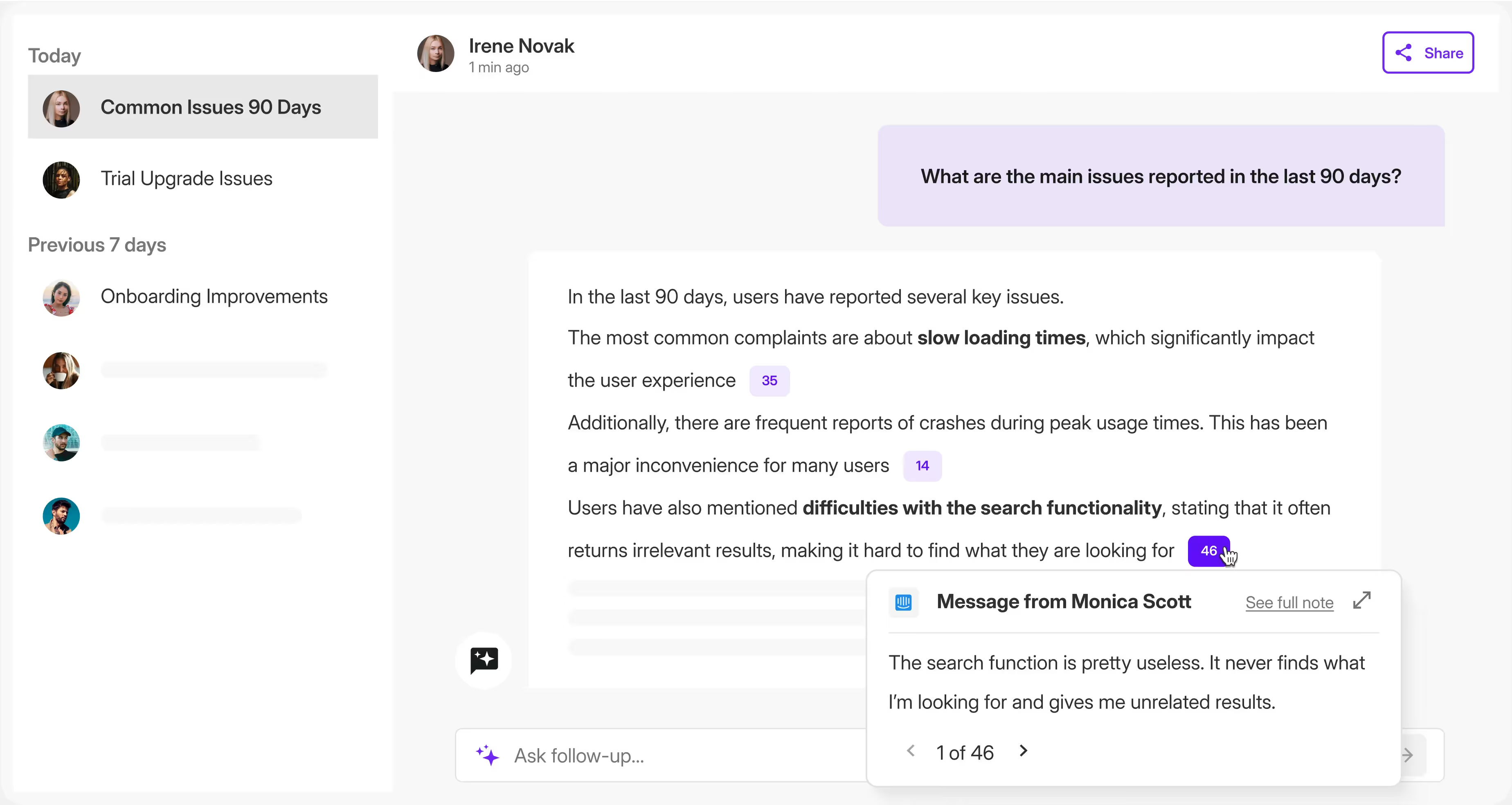
💡Tip: Survicate's Research Assistant will dig out all of the actionable insights lying deep in the feedback stored in Insights Hub. You just need to ask questions related to your customers, and the chat-based natural language processing will provide all the answers with links to the original source.
Step 4: Create a survey report
Once you perform feedback analysis, the next step is transforming raw data into actionable insights through clear reporting and visualization. Such a report should connect qualitative and quantitative data, so your stakeholders can effortlessly identify trends, and gain valuable insights to—ultimately—make data-driven decisions.
So, how should you proceed with visualising the truly insightful data? There are several ways. The most bumpy one—doing it on your own, but with all the automated tools in the market, it is really not necessary.
You can also turn to data visualization tools, but this way you only take care of the quantitative data, and that's only a part of the story your customers shared. We recommend you look for a customer feedback analytics platform capable of visualizing both qualitative and quantitative data.
If you're using customer feedback software, most platforms will do the heavy lifting for you and generate customer feedback reports automatically. They will often include visualizations that make it easier to spot customer feedback trends, so you might want to automate customer feedback analysis with tools like Survicate.
No matter which way you decide to go, there are some steps that shouldn't be omitted ⤵️
- Define the key metrics – Identify the essential data points to highlight, such as response rates, NPS trends, or sentiment distribution. Keeping the focus on the most critical insights ensures clarity in reporting.
- Segment and filter data – Breaking down responses by user demographics, behavior, or feedback category helps uncover patterns that may not be immediately obvious in aggregated data. For example, segmenting responses by customer tenure can reveal whether long-term users have different concerns than new customers.
- Use visual dashboards – A dashboard provides real-time insights into customer sentiment, making it easier to track trends at a glance. Interactive charts and graphs help stakeholders quickly grasp key takeaways without reading through extensive reports.
- Automate report generation – Setting up automated reporting ensures that relevant teams receive updated insights regularly. Scheduling reports for weekly or monthly delivery helps maintain visibility into customer feedback trends over time.
- Export and share findings – Reports should be easily accessible and shareable across teams. Whether through downloadable formats like CSV/XLSX or integrations with tools like Slack and Google Sheets, ensuring smooth distribution of insights enhances collaboration.
A well-crafted survey report summarizes data and guides decision-making. By consistently analyzing and reporting on customer feedback, you can align their strategies with evolving customer expectations.
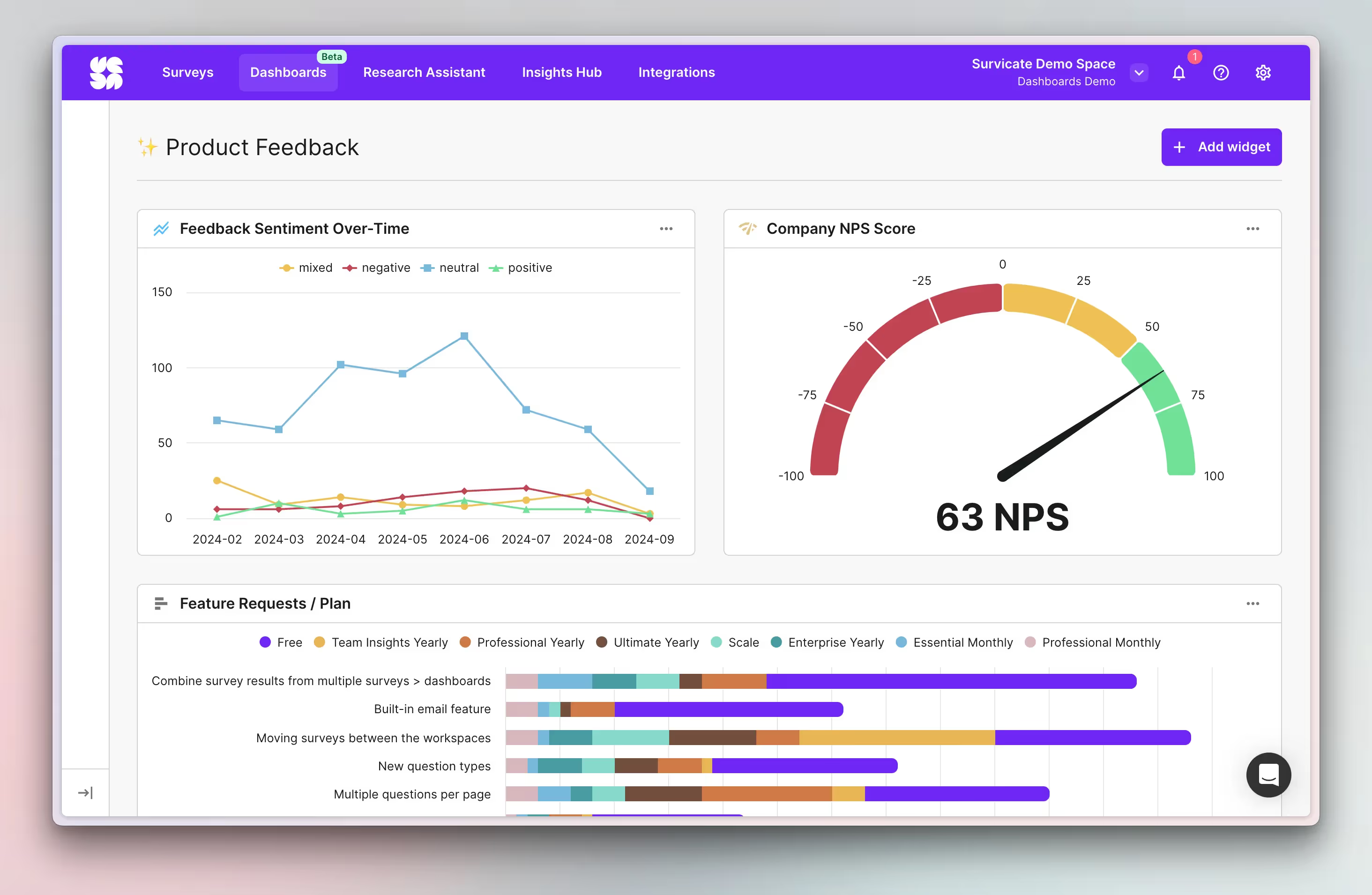
💡Tip: If you're looking for a good way to visualize your feedback data, you can try Survicate's Dashboards. This feedback analytics feature allows you to take quantitative data coming from surveys, but also the qualitative data coming from Insights Hub and combine it the way that makes the most sense for your business.
Step 5: Close the feedback loop
You managed to categorize feedback and create qualitative feedback reports. No matter if you got positive feedback or negative feedback, customer feedback data is only the first step - you now need to act on customer feedback.
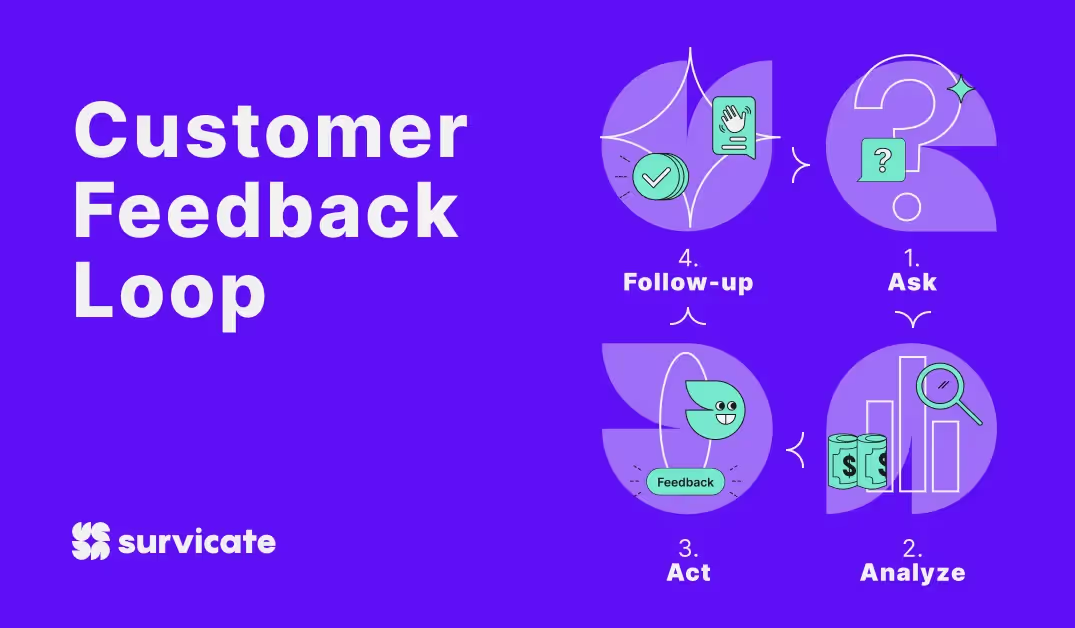
🚨 The real value of customer feedback comes from acting on it and using customer experience insights to boost your business growth.
Once trends and pain points are identified, the next step is making informed improvements. You should set up processes for responding to feedback, whether that means refining product features, improving customer support workflows, or adjusting marketing messages.
One of the best ways to ensure feedback leads to action is automating survey triggers at key touchpoints. For example, after a customer completes onboarding, a well-timed survey can gauge their experience. If a user cancels a subscription, a quick exit survey can help understand why. These automated triggers capture insights at crucial moments, ensuring timely responses.
Beyond individual improvements, you should also use advanced reporting tools to measure the impact of changes over time. Tracking key customer satisfaction metrics such as Net Promoter Score (NPS), Customer Satisfaction Score (CSAT), and Customer Effort Score (CES) provides a clear picture of whether adjustments are leading to better experiences. Filtering responses by customer segments further helps tailor solutions to different user groups.
The options are endless, but the key is to take action based on customer feedback data. Without taking action, customer feedback is nothing more than noise. This is a crucial part of closing the feedback loop and should not be neglected.
Step 6: Rinse and repeat
Customer feedback analysis is not a one-time effort—it’s an ongoing cycle of listening, improving, and refining. Even after implementing changes, you should continuously monitor feedback to ensure their adjustments are making a positive impact.
Tracking customer sentiment over time allows companies to measure whether improvements resonate with users. If satisfaction scores remain stagnant despite product updates, it may indicate the need for further refinements. Similarly, spotting new trends in feedback ensures businesses stay ahead of emerging customer needs.
The most successful companies embed feedback programs into their long-term strategies, ensuring that customer input drives decision-making at every level. By treating feedback as an iterative process rather than a one-off task, you promote a customer-centric culture that leads to sustained growth and loyalty.
Below, you'll find an exemplary workflow for getting extra rounds of feedback:
- send a survey to the customer segment as a follow-up upon implementing new features
- gather feedback, dividing it into positive and negative reviews
- analyze customer feedback and evaluate changes
- share customer insights with the team and prioritize the roadmap
- take action based on feedback data (fix bugs, create new features)
- send a message to your customers
It's very unlikely you'll please everyone, but as long as feedback data shows that you're making progress, you're on the right track.
How customer feedback analysis methods help companies grow (5 case studies)
1. Improving product development
Intergiro, a Swedish fintech company, utilized customer feedback to enhance its product offerings and speed up feature validation. By embedding surveys directly into their product, they achieved a 54% increase in engagement, leading to faster and more informed product decisions. Celina Cabral, Product Lead at Intergiro, noted:
"We increased the engagement by 54%. And this was mainly because we started running the NPS inside the product."
This approach enabled Intergiro to validate new features twice as fast, significantly accelerating their development cycle.
2. Enhancing customer support
ParkBee, specializing in urban parking solutions, leveraged customer satisfaction (CSAT) surveys to optimize its services. By collecting feedback after each parking session, they analyzed the entire customer journey—from booking to leaving the parking area—leading to a 20% reduction in customer service contact rate.
This continuous feedback loop allowed ParkBee to proactively address issues, enhancing overall customer satisfaction.
3. Boosting customer retention
Taxfix, a mobile tax filing application, employed Survicate surveys to personalize user journeys and enhance retention. By understanding user needs through targeted surveys, they achieved a Net Promoter Score (NPS) of 68, indicating high customer loyalty.
This personalized approach helped Taxfix retain users by addressing their specific needs and preferences. As Krzysztof Szymański, former Head of CRM at Taxfix, sees it:
"We combine qualitative and quantitative data to create a user profile and understand their personal preferences. It's really important to us not to guess."
4. Optimizing user experience
Workwise, a recruitment platform, used in-product surveys to gather contextual feedback from users while they were engaged with the product. This approach allowed them to understand user preferences and improve the overall user experience. Alessa Fleischer, Product Manager at Workwise, stated:
"The big advantage of Survicate is that it's very easy to set up. We have custom templates tailored to our needs, so it's just a few clicks to start getting user feedback."
By acting on this feedback, Workwise was able to make data-driven decisions that enhanced user satisfaction.
5. Improving customer satisfaction
Hitta, a Swedish search engine, continuously tracks customer satisfaction metrics to adjust their strategies and improve user engagement. By using feedback, the company ensures ongoing improvements in its services. Alice Samuelsson, Product Manager at Hitta, mentioned:
"Survicate is extremely helpful software for Hitta. The core value we’re getting is the insights into our customers, which assure us they have a happy journey with Hitta."
This proactive approach allows Hitta to stay aligned with customer expectations and maintain high satisfaction levels.
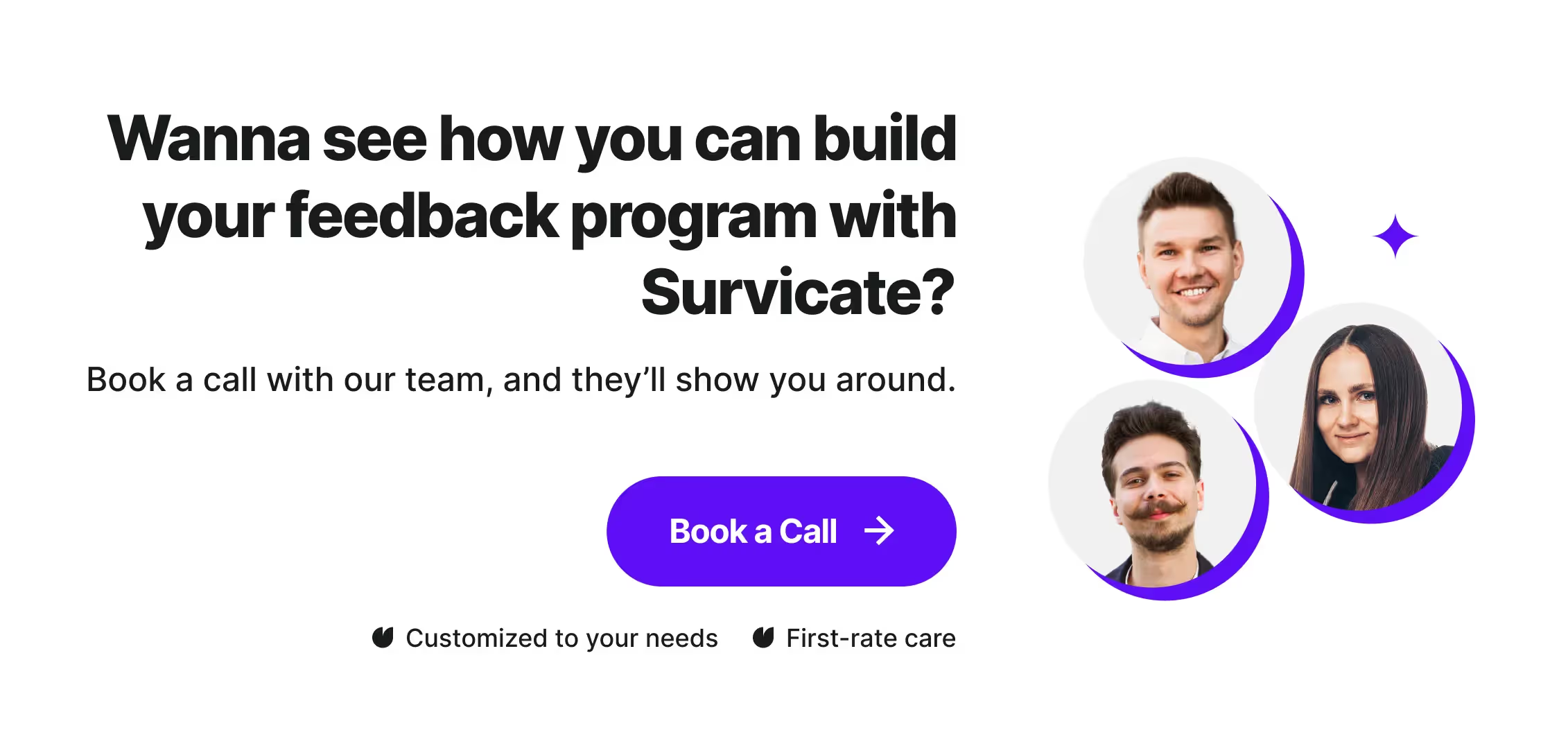
6 Benefits of customer feedback analysis for your business
Customer feedback is more than just a customer service issue or a stack of data – it's an essential part of your product strategy. And here's why:
Feedback analysis helps understand customer experience strategy better
Gathering and analyzing feedback helps you understand whether your business strategy is on the right track. It allows you to validate your hypotheses and assumptions, and course-correct if necessary. Feedback is the best way to check how the strategy KPIs and assumptions you make with your internal team relate to the sentiment and what the end users of your product(s) really want.
Feedback analysis helps prioritize projects in your product roadmap
Not sure what products and services to build next? Customer feedback analysis is here to help. It will give you a clear understanding of what your customer needs are and want, which in turn will help you prioritize your product roadmap.
Read this guide How to Build a Better Product Roadmap With Surveys to learn more about it.
It helps to improve customer experience
Analyzing the feedback from your customers can add fuel to the customer experience fire – it will help you identify and solve customer pain points, as well as improve customer satisfaction.
While there may be many sources of valuable insights, it's feedback data that will give you the clearest picture of how your customers interact with your product.
Feedback analysis can improve user onboarding
Even raw survey data can give you a some insight into what people want and provide some clues on how to optimize your processes. You can use it to identify patterns.
However, the customer feedback analysis takes things one step further by helping you understand the reasons behind those patterns.
With that knowledge, you can take action to improve user onboarding process and keep an eye on churn reduction and other key metrics you might want to scale.
Read more about it here How to Analyze Survey Results: Step-by-Step Guide.
Feedback analysis helps in boosting customer retention
Customer feedback analysis can help you reduce customer churn by addressing customer pain points. Understanding how customers feel about your product is essential to keeping them happy and engaged.
Read this guide and dive into this topic deeper Customer Churn Prevention: How to Fight with Customer Churn
Feedback analysis helps with generating new ideas for product development
Last but not least, customer feedback analysis is a key source of inspiration for new product development ideas. It will help you identify customer needs and wants, as well as unmet needs.
With that knowledge, you can come up with new products and services that your customers will be willing to pay for – which in turn will help you grow your business.
BTW: Try Survicate and start creating products people love.
Customer feedback analysis is here and now
Customer feedback analysis is not just about numbers and customer sentiment scores.
Data-driven companies are fully aware they can use customer data to boost customer loyalty, improve customer experience, and run successful products and services.
Be one of these companies.
Analyzing customer feedback is no longer optional, and manual analysis is no longer sustainable. Building a flywheel across various feedback channels and getting actionable insights on your products and services is what can take your brand places.
If you're ready to take your customer feedback analysis to the next level, sign up for Survicate today! Our tool allows you to collect feedback so you can analyze it and make data-driven decisions like never before.








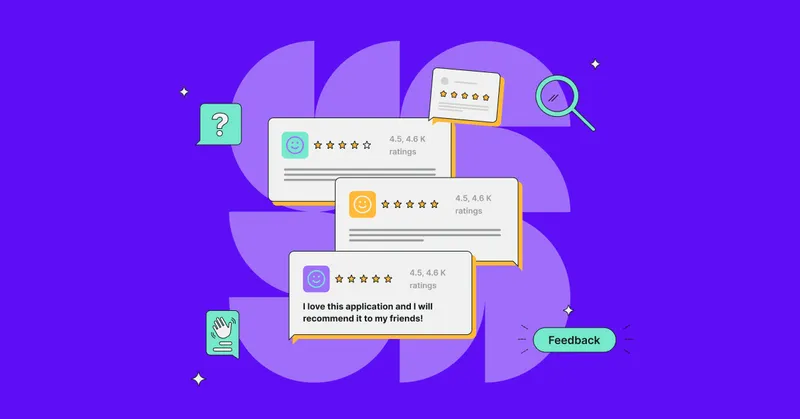
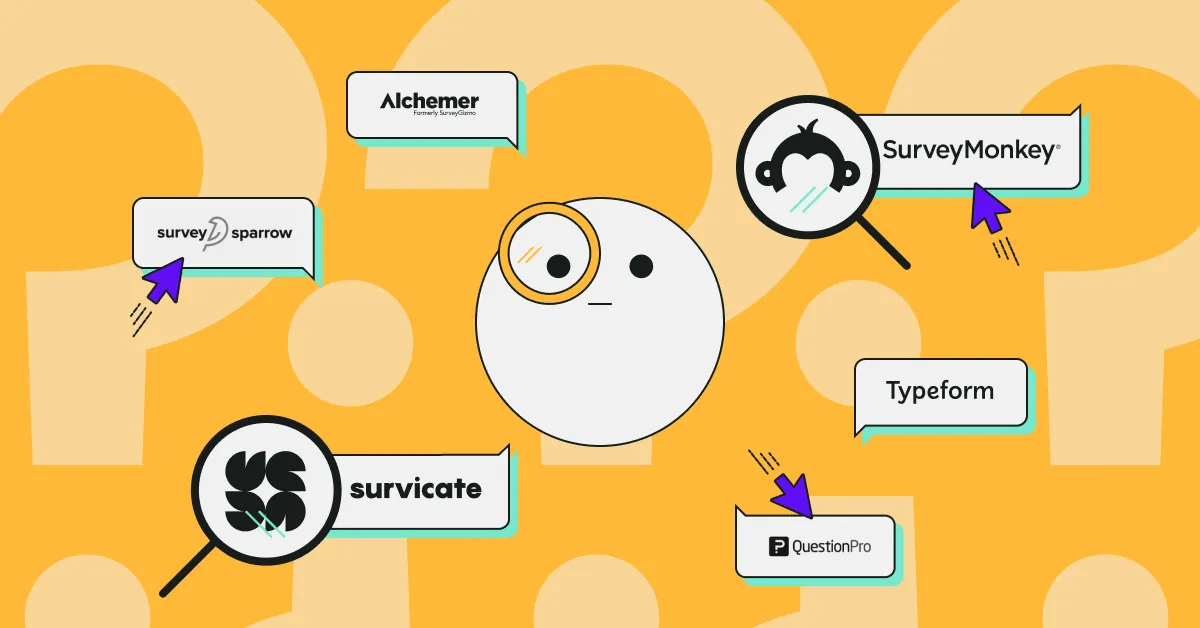

.png)

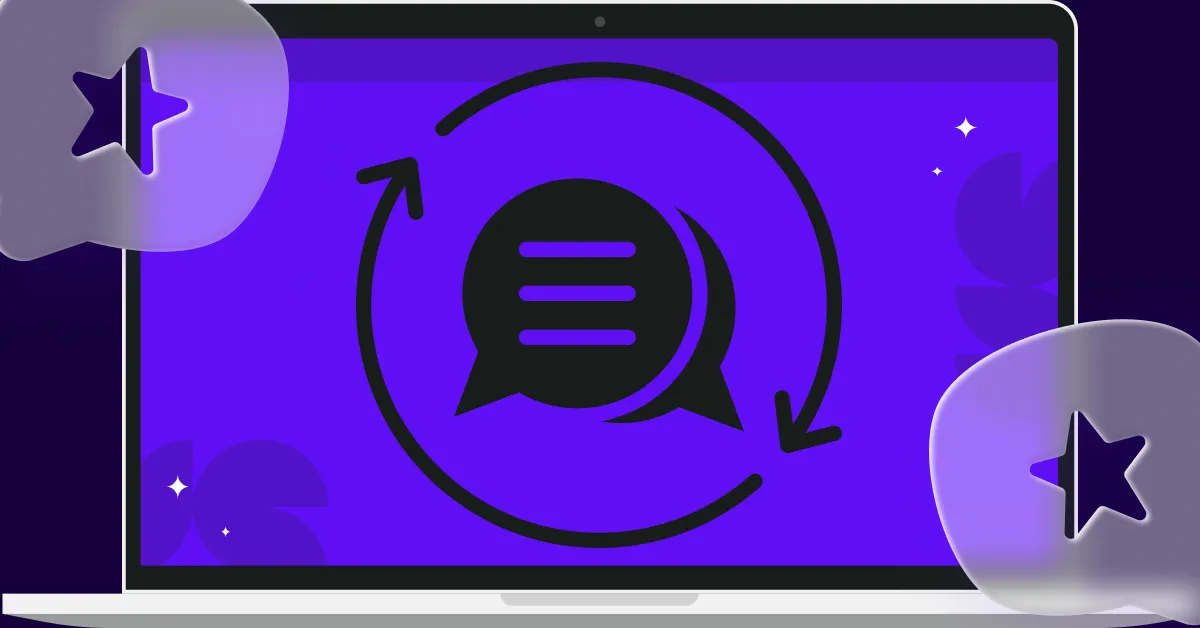

.svg)

.svg)



